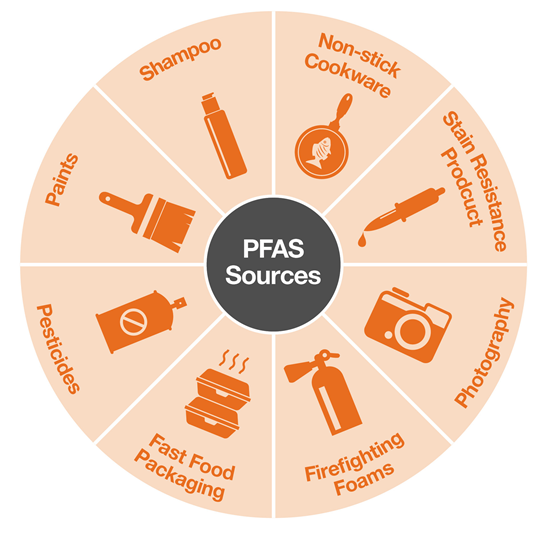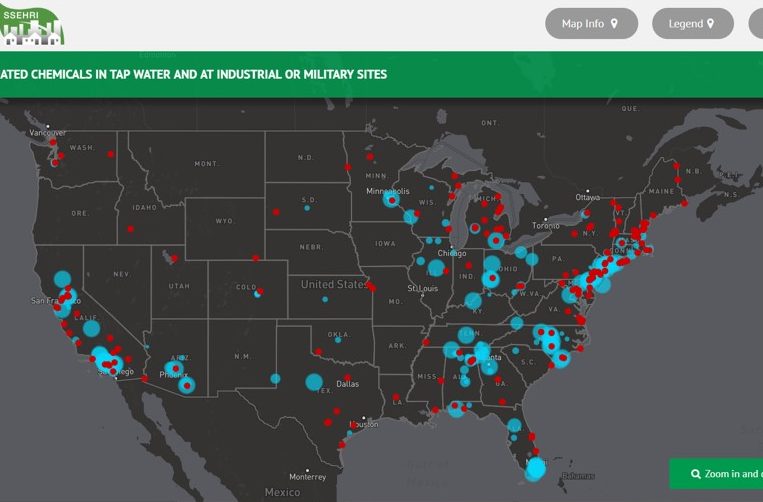In June 2017, a StarNews Online article reported that GenX, an industrial compound associated with adverse human health and ecological effects, had been detected in the drinking water system of the Cape Fear Public Utility Authority (CFPUA) and the Cape Fear River. Approximately 1.6 million people receive their drinking water from the river, with over 300,000 people serviced by CFPUA. The discovery of these emerging contaminants has caused intense and widespread public concern about potential impacts on public health, prompting a flurry of legal, regulatory, and research initiatives.
The Federation has been actively involved in all aspects of the emerging contaminant issue since the public disclosure in 2017. The Federation has provided leadership to affected communities and decision-makers, organizing the first advocacy and research presentation to the N.C. House Subcommittee on Water Quality/Emerging Contaminants, a process which eventually led to the appropriation of legislative funding to establish an early warning system to avoid contamination of this kind in the future.
This emerging contaminants page provides the public and decision-makers with current information on monitoring results and public health research, as well as current and potential policy, regulatory, and legislative needs and actions. The federation remains fully engaged on this issue; we will inform and engage impacted communities and elected officials and regulators to enable them to make informed decisions to restore and protect the human health of our citizens and the environment.
Keep up with the latest on GenX and other pressing issues by subscribing to the Federation’s advocacy newsletter!
What is GenX? What are PFAS?
GenX belongs to a group of man-made industrial chemicals – perfluoroalkyl and polyfluoroalkyl substances – otherwise known as “PFAS.” These chemicals have been manufactured and used in a variety of industries since the 1940’s; since they don’t break down, they can accumulate over time in both the environment and in the human body.
PFAS are frequently used in manufacturing because of their physical properties. They are heat resistant and oil and water repellant. This repellant nature makes them ideal for use in liquid-resistant fabrics and food wrappers which are both common in everyday life. These traits allow PFAS to be used in processes that require high resistance without breaking down, but also means they accumulate easily.
Different Types of PFAS
PFAS are broken down into two categories: long-chain and short-chain. The chain length refers to how many carbons are included in the chemical makeup of the compound. Long-chain PFAS, such as PFOS and PFOA, have a longer half-life and take more time to break down. Some manufacturers have moved to using short0chain compounds, like GenX, with the hopes of reducing environmental accumulation. But, short-chain PFAS can still accumulate in the body and environment over time with prolonged exposure. Because short-chain PFAS are a newer compound group, not as much research has been conducted about their health and environmental impact.
Where are GenX and other PFAS found?

PFAS can be found in a variety of household items. Spill-resistant carpets are often produced with PFAS to create the liquid barrier. They can also be found in food wrappers, paper products, and leather treatments. Their resistance to heat means that they’re a common ingredient in the firefighting foams used on military bases, airports, and other large scales. Firefighting foam is a quick exposure pathway into the water system because of runoff after a fire event.
Geographically, GenX and other emerging compounds have been found in locations near Chemours, a chemical plant near Fayetteville that produces these compounds during the manufacturing of Teflon. In addition to the Cape Fear River, GenX has been found in the environment close to the plant and throughout North Carolina, including in samples of surface water, groundwater and rainwater, as well as in soil and air.
How am I exposed to PFAS?
PFAS exposure can come from a variety of pathways. Primary exposure comes from diet, drinking water, and indoor dust. Current research suggests that drinking water is likely the largest exposure pathway and the most critical pathway in eastern North Carolina because of water supply contamination.

How do GenX and PFAS Impact my Health?
The exact health risks of exposure to GenX and other emerging industrial compounds remain unknown. Testing on laboratory animals links GenX to thyroid problems, increased risk of cancer, and life-threatening pregnancy complications. Emerging contaminants are not explicitly regulated under federal and state laws, and little data exists on safe levels for human consumption.
Thanks to increased awareness of these compounds, PFAS have been heavily studied in recent years. Research has shown a connection between PFAS exposure and different cancers, lymphoma, thyroid issues, immunotoxic effects, and cholesterol levels. It has also shown how easily PFAS can be transferred from mother to fetus during pregnancy. Exposure to a fetus can prove harmful because it may impact the development of different systems such as the endocrine system, cardiovascular system, and respiratory system depending on when the fetus is exposed. PFAS can also be transferred from mother-to-baby during breastfeeding.

In July 2017, N.C. Department of Health and Human Services (DHHS) set a provisional health goal of 140 parts per trillion (ppt). Initially set at 71,000 ppt, the goal was later adjusted to 140 ppt when DHHS took into account the risk of exposure over time to sensitive populations, such as pregnant women and infants. The health goal acts as a target limit, but has no regulatory effect. In August 2018, the Secretaries’ Science Advisory Board released a draft report on the review of the health goal and the EPA published a draft toxicity assessment in November 2018.
PFAS Testing Network
Earlier in 2018, the N.C. General Assembly funded a statewide PFAS Testing Network. The network is a collaboration among six North Carolina universities designed to document and understand PFAS exposure in the state. This research effort will test for the presence of PFAS (including GenX) in water and air samples collected statewide. This research model is the first of its kind for any state in the country and the research team is hopeful that it could motivate other states to develop similar research programs to study PFAS in the environment. Information from the PFAS Testing Network will be shared to inform public policy efforts to enhance public health safeguards.
Take Action
Your voice matters, and you can make a difference is several ways.
Stay informed and share this information with your communities, and with your state and local governments and elected officials. Encourage them to ensure that adequate funding is available to continue critical research about the extent of the PFAS contamination in our drinking water and environment, and the effects of these compounds on human health and our ecosystem. Unbiased research findings are needed to guide legislative, policy, and health decisions.
Contact your representatives
Download a list of names and contact information for federal, state, and local representatives in North Carolina. A simple phone call voicing your concerns can truly make a difference.
Stay informed
Sign up for our action alerts and stay up to date on statewide monitoring and research through the PFAS Testing Network and newsletter. Please support your local organizations so that we can continue our efforts to advocate on these issues.
Switch to PFAS-free products
Instead of popping bagged popcorn, buy kernels to pop on the stove. Look into the ingredient lists of water-resistant products you buy and support companies that pledge against PFAS use.
Resources
Read More
News releases and presentations related to the GenX crisis can be found on the NC Department of Environmental Quality GenX Investigation website. For a detailed timeline of the long-term industrial contamination of drinking water supply from the Cape Fear River, as well as current levels of GenX in finished water at the CFPUA Sweeney Treatment Plant, visit the CFPUA Emerging Compounds website and please continue to check our website for updates as we continue work on this important issue.
Legislation, Comments, FAQs & Presentations
- Current PFAS Legislation
- SELC Comments on CCL 5 Nominations 12.4.18
- EPA Fact Sheet Draft Toxicity Assessment 11/14/18
- GenX Exposure Study CHHE 11.13.18
- CFPUA Community Forum 11/14/18
- SELC Comments on EPA PFAS docket 9/28/18
- SELC Comments on GenX Health Goal 9/27/18
- DEQ and DHHS Science Advisory Board Health Goal for GenX
- CFPUA Board Workshop Presentations 8/15/18
- EPA PFAS Community Engagement Event Presentations 8/14/18
- DEQ GenX Frequently Asked Questions
- EPA PFOA & PFOS Drinking Water Health Advisories
- ATSDR PFAS Fact Sheet
- ITRC PFAS Transport Fact Sheet
- EWG Guide to Avoiding PFAS Chemicals
- Environment NC GenX and Emerging Contaminants
- Dr. Lee Ferguson’s Presentation to General Assembly 9/28/17
- Federation Comments to General Assembly 9/28/17
In the News
Coastal Review Coverage:
From Other News Sources:
- House bill would ban sale, production of PFAS in North Carolina
May 15 – NC Policy Watch - Brunswick County tops national list for PFAS contamination
Jan. 22 – Wilmington Star News - PFAS Found in Biodegradable Food Packaging
Sept. 30 – Coastal Review Online - Levels of cancer-causing 1,4-Dioxane rise in Cape Fear River, drinking water
Sept. 26 – NC Policy Watch - A new drinking water crisis hits US military bases across the nation
July 13 – CNBC - GenX: Two Years Burning Down the Road
June 10 – WHQR - EPA to Fund Study on Whether Treating Drinking Water Limits PFAS Exposure
May 2 – NCSU - Scientists dig into hard questions about the fluorinated pollutants known as PFAS
April 22 – NPR - Scientists update lawmakers on PFAS research, including presence of compounds in food
April 10 – NC Policy Watch - Should you be concerned about PFAS chemicals
April 8 – Consumer Reports - Researching the health effects of PFAS
January 10 – ECU News Service
From around the web
- Fall 2018 Symposium: “Emerging Contaminants in the Ambient Environment: Perspectives to Guide North Carolina’s PFAS Monitoring Network”
- Consumer Notice
- PFAS Central
- PFAST Network
- National PFAS Contamination Coalition
- PFAS Chemicals and Community Health
- Six Classes: Green Science Policy Institute
- NCDEQ GenX Investigation Website
- C8 Science Panel
- Smith Environment Blog
- CFPUA Emerging Compounds
- Clean Cape Fear
- Cape Fear River Watch GenX
- EWG Mapping Expanded PFAS Crisis
- Southern Environmental Law Center Clean Water
- NCSU Center for Human Health and the Environment
- Asbestos in the Water
Questions? Contact Tracy Skrabal at tracys@nccoast.org or Kerri Allen at kerria@nccoast.org. You can also reach them at 910-509-2838.
Keep up with the latest on GenX and other pressing issues by subscribing to the federation’s advocacy newsletter!
Protect Clean Water
You can protect and restore water for fishing, swimming and working.

